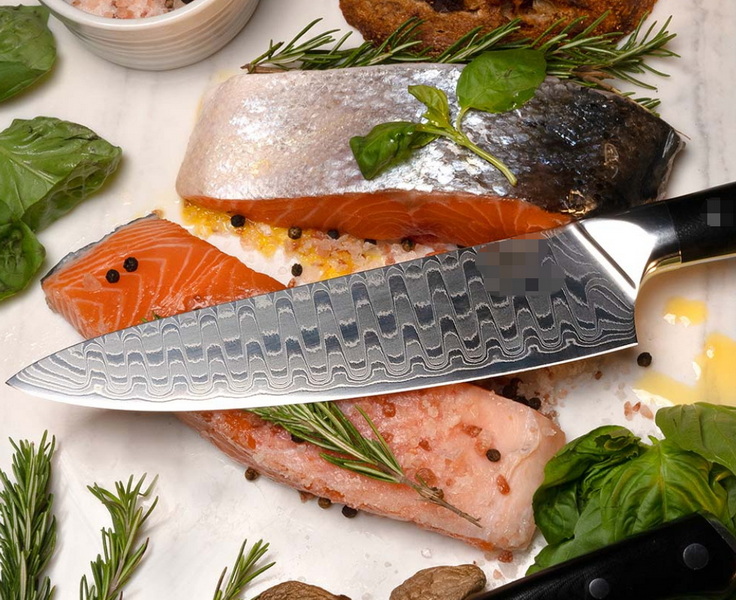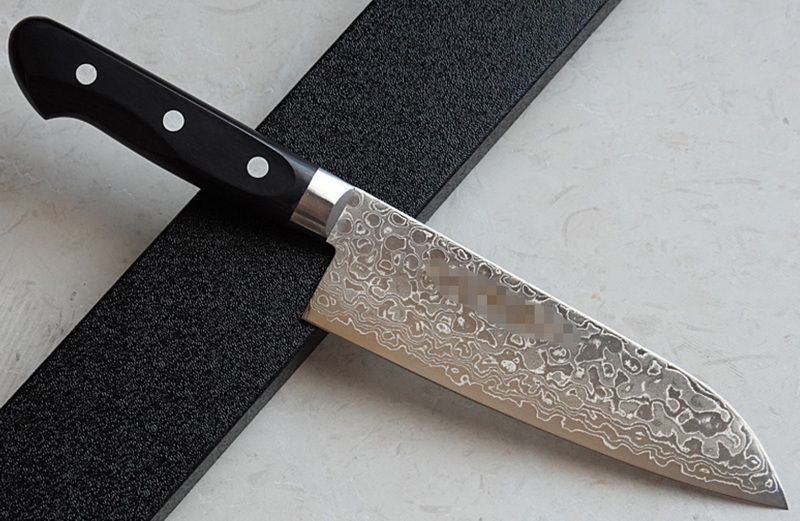- All
- Product Name
- Product Keyword
- Product Model
- Product Summary
- Product Description
- Multi Field Search
Views: 222 Author: Ann Publish Time: 2025-10-19 Origin: Site











Content Menu
● Blade Design and Steel Composition
● Handle Design and Ergonomics
● Craftsmanship and Manufacturing Techniques
● Usage and Culinary Applications
● Frequently Asked Questions (FAQs)
>> 1. What defines a Damascus knife?
>> 2. Which is sharper, Japanese or Western Damascus knives?
>> 3. How do I properly maintain a Japanese Damascus knife?
>> 4. Can Western Damascus knives cut through bones?
>> 5. Are Damascus knives worth the investment?
Damascus knives are renowned worldwide for their distinctive patterned blades and exceptional cutting performance. Among these, Western and Japanese styles of Damascus knives are the most prominent, each reflecting unique cultural craftsmanship and culinary traditions. This article presents a thorough comparison between Western and Japanese Damascus knives, delving into blade design, steel composition, handle ergonomics, crafting methods, maintenance, and culinary applications. By exploring these facets, culinary enthusiasts and professionals can better determine which style aligns with their kitchen needs.

The blade design and steel makeup form the foundation distinguishing Western and Japanese Damascus knives. Japanese Damascus knives typically employ harder high-carbon steel, with Rockwell hardness (HRC) ratings between 60 and 65. This higher hardness allows a finer, razor-sharp edge ideally suited for precision slicing of delicate items such as sashimi and thin vegetables. These blades are thinner and have an acute edge angle of approximately 12° to 16° per side, facilitating accurate and clean cuts. However, this hardness introduces brittleness, making the knives susceptible to chipping if used improperly.
Western Damascus knives, by contrast, use comparatively softer stainless steel, usually around 54 to 58 HRC. This steel is tougher and more flexible, designed to withstand rigorous tasks such as chopping through bones and dense vegetables. Western blades are thicker, heavier, and typically sharpened at wider edge angles of about 17° to 22° per side. This tradeoff provides excellent durability and edge retention during heavy-duty kitchen work at the cost of extreme sharpness.
Handle construction varies greatly between the two styles and strongly influences user comfort and control. Japanese Damascus knives commonly feature traditional wooden Wa-handles, which are light, often octagonal or D-shaped, and attached using a partial or hidden tang. These handles contribute to a lighter blade-forward balance, reducing wrist fatigue for prolonged, precise cutting tasks. Because the handle can sometimes be replaced independently from the blade, it supports long-term use and maintenance aligned with Japanese philosophies of tool longevity.
Western Damascus knives generally exhibit heavier, riveted Yo-handles made from composite materials or hard wood, with a full tang extending through the handle for enhanced durability and balance. Their bolster offers finger protection and a solid grip, favoring a rocking chopping motion which is typical in Western culinary styles.
Japanese Damascus knives are often handmade using centuries-old forging techniques combining multiple layers of steel to create both the iconic Damascus pattern and high-performance blades. The artisan focus extends to hand polishing, sharpening, and finishing, resulting in knives prized for their sharpness, aesthetics, and finesse.
Western Damascus knives combine machine precision and artisan finishing in their production process. Their crafting often prioritizes robustness and versatility with visually dramatic Damascus layering suited for heavier kitchen work. While handmade Western Damascus knives are available, many models are efficiently manufactured to balance quality with affordability.
Japanese Damascus knives excel in tasks requiring precise, thin slicing, such as preparing sushi, sashimi, and vegetables. Their sharpness and thin blade enable clean cuts that preserve ingredient texture and appearance, making them indispensable in cuisines emphasizing delicate presentations.
Western Damascus knives are better matched to heavy-duty kitchen work, including butchery, chopping root vegetables, and general-purpose cookery. The thicker blade and rocking edge design enhance power and resilience, making these knives durable workhorses in professional and home kitchens alike.

Due to their hard steel and fine edges, Japanese Damascus knives demand meticulous upkeep. Regular sharpening with a whetstone is important to maintain sharpness, and careful drying is necessary to prevent rust. Their brittleness also requires cautious handling to avoid chipping.
Western Damascus knives, with softer stainless steel, require less-intensive maintenance. Honing with a steel rod and occasional sharpening suffice, and their corrosion resistance suits users seeking low-upkeep options without compromising cutting ability.
Japanese Damascus knives are typically lighter with a blade-forward weight distribution, which aids maneuverability and reduces fatigue. Their slender blades and Wa-handles make them agile for extended precision work.
Western knives are heavier with a centered balance point due to full tangs and substantial handles, preferred for tasks demanding power and stability, such as chopping large or tough ingredients.
Japanese Damascus knives often command higher prices due to artisan craftsmanship, premium steel, and intricate forging processes. They appeal to professionals and enthusiasts prioritizing sharpness, aesthetics, and specialized performance.
Western Damascus knives offer competitive pricing and durability, suitable for beginners and those seeking long-lasting versatility with manageable maintenance demands.
Choosing between Western and Japanese Damascus knives depends on culinary priorities. Japanese knives provide unmatched sharpness, precision, and elegance, perfect for delicate tasks and fine presentation. Western knives deliver robust durability, versatility, and easier upkeep, ideal for heavy-duty, all-purpose kitchen work. Understanding these distinctions helps chefs select the Damascus knife style that best complements their cooking style and needs.
Damascus knives are made by folding and layering different steel types during forging, creating the unique wavy patterns and combining hardness with flexibility.
Japanese Damascus knives are sharper and maintain an edge longer due to harder steel, but they are more fragile. Western knives are less sharp but tougher and better suited for heavy tasks.
Use a whetstone for sharpening, keep the blade dry to prevent rust, and avoid cutting bones or hard materials to prevent chipping.
Yes, their tougher steel and wider edge angles make them suitable for light bone cutting, unlike most Japanese knives.
Yes, they offer superior cutting performance, durability, and aesthetic value, making them a valuable addition to any kitchen.
The Ultimate Professional Knives for Halal Butchery in Middle Eastern Kitchens
Chef Knife Size Guide: Choosing Between 6″, 8″, 10″, And 12″
Custom Knife Handles: How To Design A Chef Knife That Fits Your Hand Perfectly
Chef Knife Surface Treatments Guide: From Polished Migaki To Damascus Patterns
Inside Our Professional Knife Sample Room: Quality You Can See
Universal Knife Block Buying Guide: Modern Acrylic & ABS Knife Holders for Professional Kitchens
Universal Knife Block: The Complete Guide To Modern, Hygienic Knife Storage
The Complete Guide To Red Handle Knife Sets: Style Meets Functionality in The Kitchen
Professional Knives for Halal Butchery And Middle Eastern Cuisine